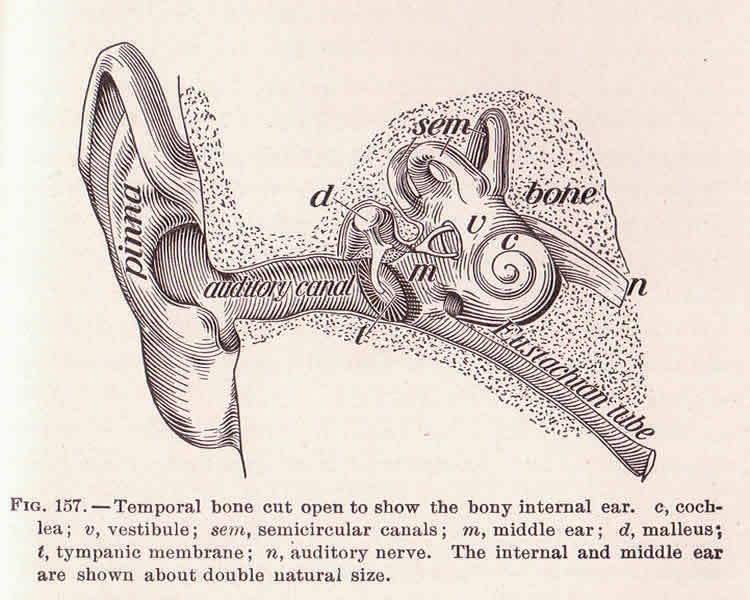Summary: A new hearing test is able to pick up hearing deficits that may go undetected with a traditional hearing test or audiogram.
Source: University of Connecticut.
Two researchers at UConn School of Medicine have developed a new hearing test that can identify hearing loss or deficits in some individuals considered to have normal or near-normal hearing in traditional tests.
Many adults report difficulties hearing in everyday situations, despite having their physicians or audiologists tell them that the results of their hearing tests are normal or near-normal.
“We now have a validated technique to identify ‘hidden’ hearing deficits that would likely go undetected with traditional audiograms,” says Leslie R. Bernstein, professor of neuroscience and surgery at UConn, who conducted the study with Constantine Trahiotis, emeritus professor of neuroscience and surgery.
Their newly developed hearing test measures a person’s ability to detect across-ears (binaural) changes in sounds presented at levels of loudness that are close to those experienced in normal conversations.
The binaural system plays a fundamental and predominant role in the ability to localize sounds, to understand conversation in places such as busy restaurants, and to attend to one of multiple, simultaneous sounds.
The researchers studied 31 adults ages 30 to 67 with normal or near-normal audiograms. They found that listeners who have essentially normal clinical hearing test results may exhibit substantial deficits in binaural processing. The results of the study have been published in the Journal of the Acoustic Society of America.
“Our study shows that our novel binaural hearing test can help early identify vulnerable populations of listeners, and perhaps help determine when critical interventions are warranted,” says Trahiotis.
Bernstein and Trahiotis, who have been colleagues for nearly 40 years, including 29 at UConn School of Medicine, are widely considered to be at the forefront of binaural auditory research.
Bernstein notes that acquired hearing loss from excessive noise exposure has long been known to produce significant, and sometimes debilitating, hearing deficits. The new research suggests that hearing loss may be even more widespread than was once thought.
He says experts in the field, for example, used to think that post-concert hearing loss or ear ringing was only a temporary injury that went away. But this new, mounting evidence may change expert opinion.

Hearing problems pose substantial societal and economic problems for the approximately 15 percent of American adults who report some kind of trouble hearing. Worldwide, 360 million people have disabling hearing loss, with the World Health Organization projecting that 1.1 billion teenagers and young adults are at risk of hearing loss due to the lingering effects of excessive noise from personal audio devices and loud concerts.
“Our research team has been working hard to define what normal human hearing really is,” says Trahiotis. “Greater understanding of normal hearing and the early detection of any underlying slight hearing deficits in supposed ‘normal’ listeners could help practitioners have a better chance of identifying ways to slow the progression of debilitating hearing loss in one’s lifetime, and even possibly finding future ways to restore it.”
Funding: The team’s research is funded through a $1.5 million grant by the Office of Naval Research. The U.S. Navy has a keen interest in finding new ways to protect its workforce, some of whom are known to be at high risk of noise-induced hearing loss caused by exposure to excessively loud sounds.
Source: Lauren Woods – University of Connecticut
Image Source: NeuroscienceNews.com image is for illustrative purposes only.
Original Research: Abstract for “Behavioral manifestations of audiometrically-defined “slight” or “hidden” hearing loss revealed by measures of binaural detection” by Leslie R. Bernstein and Constantine Trahiotis in Journal of the Acoustical Society of America. Published online October 2016 doi:10.1121/1.4966113
[cbtabs][cbtab title=”MLA”]University of Connecticut “New Test Can Detect Hidden Hearing Loss.” NeuroscienceNews. NeuroscienceNews, 22 December 2016.
<https://neurosciencenews.com/hidden-hearing-loss-test-5802/>.[/cbtab][cbtab title=”APA”]University of Connecticut (2016, December 22). New Test Can Detect Hidden Hearing Loss. NeuroscienceNew. Retrieved December 22, 2016 from https://neurosciencenews.com/hidden-hearing-loss-test-5802/[/cbtab][cbtab title=”Chicago”]University of Connecticut “New Test Can Detect Hidden Hearing Loss.” https://neurosciencenews.com/hidden-hearing-loss-test-5802/ (accessed December 22, 2016).[/cbtab][/cbtabs]
Abstract
Behavioral manifestations of audiometrically-defined “slight” or “hidden” hearing loss revealed by measures of binaural detection
This study assessed whether audiometrically-defined “slight” or “hidden” hearing losses might be associated with degradations in binaural processing as measured in binaural detection experiments employing interaurally delayed signals and maskers. Thirty-one listeners participated, all having no greater than slight hearing losses (i.e., no thresholds greater than 25 dB HL). Across the 31 listeners and consistent with the findings of Bernstein and Trahiotis [(2015). J. Acoust. Soc. Am. 138, EL474–EL479] binaural detection thresholds at 500 Hz and 4 kHz increased with increasing magnitude of interaural delay, suggesting a loss of precision of coding with magnitude of interaural delay. Binaural detection thresholds were consistently found to be elevated for listeners whose absolute thresholds at 4 kHz exceeded 7.5 dB HL. No such elevations were observed in conditions having no binaural cues available to aid detection (i.e., “monaural” conditions). Partitioning and analyses of the data revealed that those elevated thresholds (1) were more attributable to hearing level than to age and (2) result from increased levels of internal noise. The data suggest that listeners whose high-frequency monaural hearing status would be classified audiometrically as being normal or “slight loss” may exhibit substantial and perceptually meaningful losses of binaural processing.
“Behavioral manifestations of audiometrically-defined “slight” or “hidden” hearing loss revealed by measures of binaural detection” by Leslie R. Bernstein and Constantine Trahiotis in Journal of the Acoustical Society of America. Published online October 2016 doi:10.1121/1.4966113






